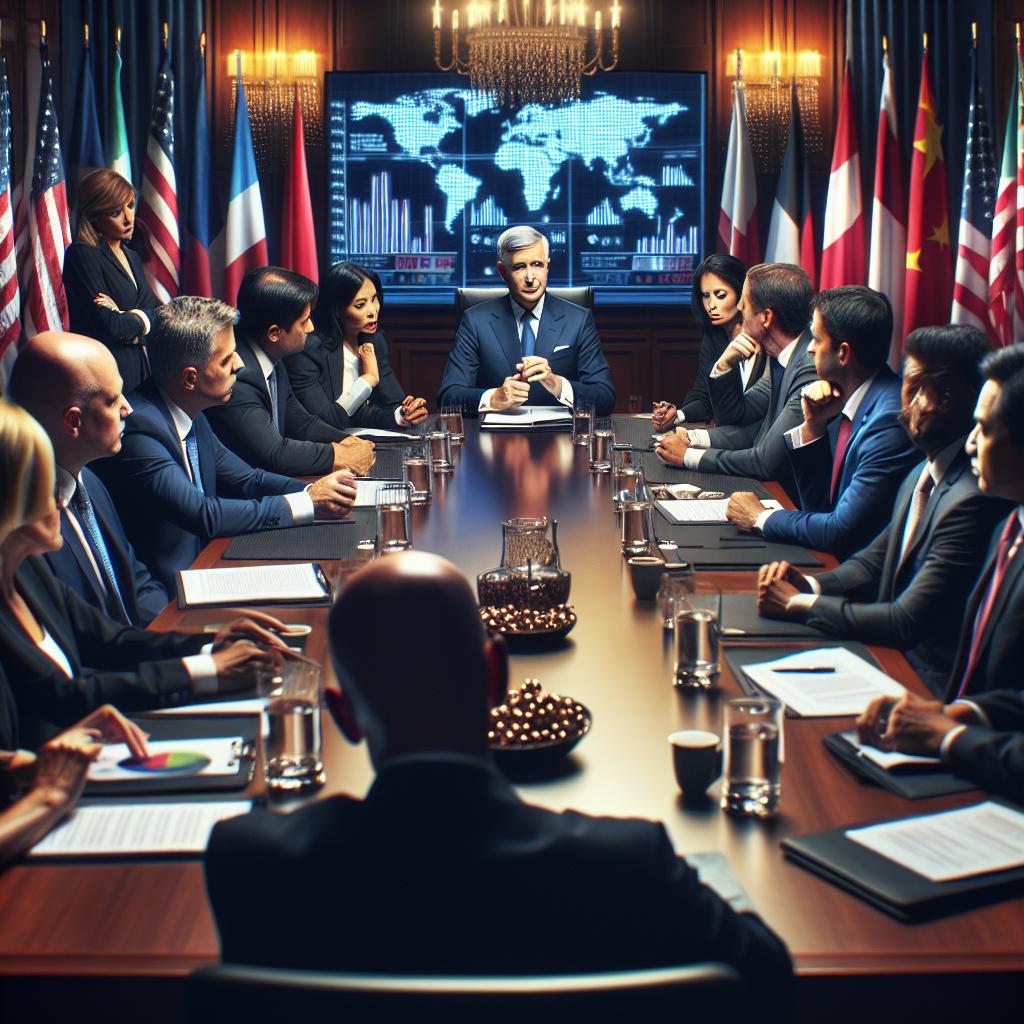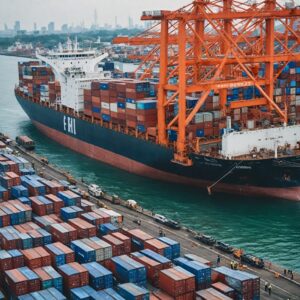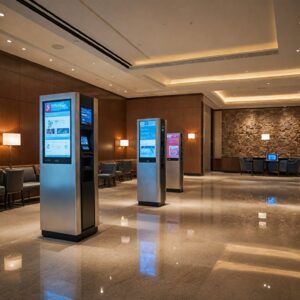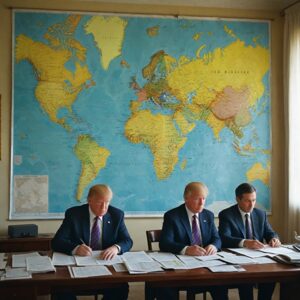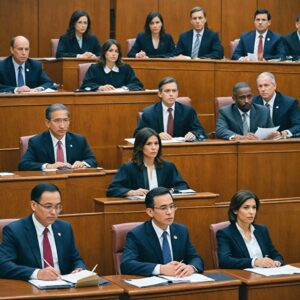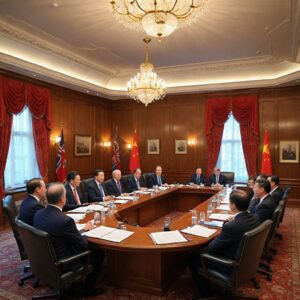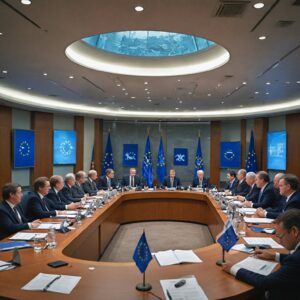Summary
**Exclusive: Trump Gathers Top Retail Executives for High-Stakes Tariff Talks**
In 2024, amid escalating trade tensions and the implementation of sweeping reciprocal tariffs, President Donald Trump convened a high-profile meeting with chief executives from some of America’s largest retail companies to discuss the impact of his trade policies on the sector. These tariffs, which imposed a baseline 10% duty on imports from nearly all countries and higher rates on key trading partners such as China and the European Union, marked a significant shift toward protectionism aimed at addressing the U.S. trade deficit and promoting domestic manufacturing. The meeting reflected the administration’s commitment to defending its tariff agenda while seeking input from retail leaders who navigate complex supply chains heavily reliant on imports.
Retail executives from companies including Walmart, Target, and Home Depot, representing the Retail Industry Leaders Association (RILA), voiced concerns about the tariffs’ potential to increase costs on everyday consumer goods and erode profit margins in an already challenging economic climate characterized by inflationary pressures. Despite these worries, the CEOs engaged in a cautiously constructive dialogue with the administration, emphasizing the importance of thoughtful tax reform and collaboration to protect American businesses and working families. The talks also occurred against a backdrop of broader negotiations with Congress and international trading partners, underscoring the high stakes of U.S. trade policy amid fears of retaliation and market uncertainty.
The tariff discussions generated mixed reactions across corporate America and internationally. While some business leaders welcomed aspects of the administration’s economic agenda, many expressed unease about the unpredictability and potential inflationary effects of the tariffs. Internationally, affected countries including the European Union, China, South Africa, and Lesotho engaged in diplomatic efforts to mitigate tariff impacts and avoid escalation, with the EU preparing retaliatory measures amid ongoing negotiations. These developments highlighted the complexities and controversies surrounding the Trump administration’s protectionist trade approach and its implications for global commerce.
Overall, the meeting between President Trump and retail leaders was notable for underscoring the administration’s firm stance on tariffs as a tool for economic and national security priorities, while illuminating the challenges faced by import-dependent industries in balancing competitive pricing and policy compliance. The dialogue illustrated both the opportunities and risks inherent in the evolving U.S. trade landscape and set the stage for continued negotiations on tariffs, tax reform, and broader economic strategies impacting American consumers and businesses alike.
Background
In the context of rising trade tensions and shifting U.S. trade policies, President Trump introduced a series of sweeping “reciprocal tariffs” aimed at reshaping decades of international commerce. His plan included a 10% baseline tariff on imports from nearly all countries, with particularly steep duties imposed on major trading partners such as China and the European Union, where tariffs reached up to 34% and 20%, respectively. These measures marked a significant shift toward protectionism, generating considerable uncertainty among businesses and consumers.
The tariff strategy elicited mixed reactions from various sectors. While some government officials, including former Treasury Secretary Steve Mnuchin, expressed hope that reciprocal tariffs would be negotiated down, many industry groups voiced concern over the potential economic impact. A 2024 study found that the tariffs strengthened certain segments of the U.S. economy and contributed to notable reshoring in industries like manufacturing and steel production. Nonetheless, for the retail sector, tariffs represented an added challenge amid an already difficult economic environment characterized by consumers’ sensitivity to price increases following years of inflation.
Retail Industry Leaders Association (RILA), which represents major retail corporations, was particularly vocal about the risks associated with these tariffs. Its members, including executives from companies such as Gap Inc., Target, and Best Buy, highlighted how tariffs would increase costs for everyday consumer goods, from sneakers to household appliances. The CEOs collectively urged for a thoughtful approach to tax reform and trade policy, emphasizing the need to protect both American businesses and working families who are their customers. This backdrop set the stage for high-stakes discussions between President Trump and top retail executives, as the industry sought to navigate the complexities of the new trade landscape while maintaining stability for their operations and consumers.
Meetings with Retail Executives
In a high-profile effort to address the impact of his tariff policies on major American retailers, President Donald Trump convened a meeting with chief executives from some of the nation’s largest retail companies. The meeting, held at the White House, brought together Walmart CEO Doug McMillon, Target CEO Brian Cornell, and Home Depot CEO Ted Decker to discuss the implications of sweeping tariffs on their import-reliant business models.
This gathering marked McMillon’s first direct engagement with President Trump since the introduction of the so-called “Liberation Day” tariffs. Although McMillon noted that he had not personally discussed tariffs with the President prior to the meeting, Walmart’s leadership had maintained regular communication with the administration regarding trade concerns. Both Walmart and Target reported that more than half of their imports originated from China, while Home Depot and Lowe’s also depended heavily on imports from the country, raising concerns about the potential impact of tariffs on profit margins.
Following the meeting, the three attending companies issued nearly identical statements emphasizing a “productive meeting” and an appreciation for the opportunity to share their insights on trade policy. Walmart’s spokesperson highlighted the constructive nature of the discussion, and Target reaffirmed its commitment to delivering value for American consumers amid ongoing trade negotiations. Notably, Lowe’s, initially expected to attend, did not participate in the meeting and did not provide immediate comment.
Beyond the White House, the retail CEOs also met with key Congressional figures, including Representative Kevin Brady, chairman of the House Ways and Means Committee, and Senator Orrin Hatch, chairman of the Senate Finance Committee, to further discuss tax reform and trade policy. The assembled executives represented the Retail Industry Leaders Association (RILA), chaired by AutoZone CEO Bill Rhodes. Rhodes characterized the conversations as “positive and productive,” underscoring the importance of a thoughtful approach to both individual and corporate tax reform while expressing a commitment to working closely with the administration on issues critical to the industry and American working families.
The meetings came amid a broader climate of uncertainty around the administration’s tariff agenda. While President Trump maintained that his tariffs were having a “tremendously positive impact,” many companies faced market volatility and concerns over rising costs. The scarcity of specific details regarding the reciprocal tariff plans led to widespread discussions among businesses and advertisers seeking to adapt quickly as the trade environment evolved.
Agenda and Objectives
President Donald Trump convened a meeting with eight top retail CEOs to discuss critical issues surrounding tax reform and trade policy, with a particular focus on tariffs and their impact on the U.S. economy and consumers. The primary objective of the meeting was to explore pathways forward on trade that would support American manufacturing, protect jobs, and deliver value to consumers across the country.
A central agenda item was the administration’s reciprocal tariff policy, which imposes a 10% minimum tariff on goods imported from all countries, with higher tariffs applied to trading partners that maintain restrictive trade barriers. This approach aims to counteract both monetary and non-monetary trade barriers and address the substantial U.S. trade deficit, which exceeded $1.2 trillion in goods in 2024. The tariffs are intended not only to protect American industries but also to encourage reshoring of manufacturing jobs and bolster national economic security.
In addition to tariffs, the discussion emphasized the importance of thoughtful tax reform for both individuals and corporations. Retail Industry Leaders Association (RILA) Chair Bill Rhodes and other executives underscored the need for tax policies that support the industry, its employees, and American working families. While some CEOs expressed opposition to protectionist measures such as a proposed “border tax” on imports, the overall tone of the meeting was constructive, with an emphasis on collaboration with the President and his administration to address key economic challenges.
Starmer also commented on ongoing negotiations related to an “economic prosperity deal,” indicating that discussions would continue but only if the outcomes align with the national interest. He noted that the UK holds various strategic levers but refrained from providing further specifics.
Discussions and Negotiations
In response to the sweeping tariffs imposed by President Donald Trump, numerous discussions and negotiations have taken place between the White House and various stakeholders, including foreign governments and U.S. retail industry leaders. Despite mixed signals from the administration on the willingness to negotiate, President Trump indicated that talks with other countries requesting meetings would begin immediately following the tariff announcements. The White House has also encouraged trading partners to approach negotiations creatively, often beyond the scope of trade itself, signaling an openness to dialogue despite the uncertainty surrounding the precise conditions for tariff relief.
The Retail Industry Leaders Association (RILA), representing major U.S. retailers, has been actively involved in these discussions. Executives from leading companies such as Target, Best Buy, and AutoZone met with President Trump and his team to convey their concerns and to advocate for a measured approach to tax and trade policies. RILA’s CEO Bill Rhodes described the meeting as “positive and productive,” emphasizing the importance of thoughtful tax reform and expressing a willingness to collaborate with the administration on issues impacting the industry and American consumers. While some retail leaders oppose protectionist measures like a proposed “border tax,” they have generally adopted cautious public rhetoric to maintain constructive relations with the administration.
Internationally, several countries have expressed concern over the tariffs and sought negotiations to mitigate their impact. For example, Lesotho assembled a delegation to protest tariffs affecting its exports to the United States, including denim products for major brands. South Africa also emphasized the urgency of negotiating a bilateral trade agreement to secure long-term certainty amidst the new duties. The European Union and China have both indicated interest in trade talks, with the EU preparing retaliatory measures should negotiations fail and China imposing high tariffs on U.S. imports in response.
U.S. retailers are particularly exposed to these tariffs given their reliance on imported goods, especially from countries like Vietnam and China. The tariffs have heightened concerns over increased costs for consumers on everyday items such as sneakers, toasters, and mattresses, which could exacerbate economic challenges posed by ongoing inflation. Major retail chains like Walmart and Target, which depend heavily on imports, have acknowledged the strain the tariffs place on supply chains and pricing.
Amidst this complex landscape, the administration’s tariff policy includes a 10% baseline tariff on goods from all countries, with some partners facing higher “reciprocal tariffs” as penalties for their trade barriers. However, specific details regarding exemptions and affected products remain evolving, prompting industries such as automotive to seek greater clarity, especially given the intricate global supply chains involved in vehicle manufacturing.
Reactions and Responses
Corporate America’s response to the tariff announcements has been marked by cautious diplomacy. While many big companies brace for the impact of market volatility and tariffs, business leaders generally welcome President Trump’s broader economic agenda, including lower taxes and reduced regulations. However, there is a noticeable reluctance among CEOs to publicly criticize the president, contrasting with earlier instances during Trump’s first term when some resigned from advisory councils over issues such as the handling of racial violence in Charlottesville.
Retail industry executives, particularly those represented by the Retail Industry Leaders Association (RILA), which includes major companies like Target, Best Buy, Walmart, Home Depot, and Lowe’s, have expressed concern about the tariffs’ potential to reduce profit margins due to their heavy reliance on imports from China. Despite these worries, RILA’s leadership has emphasized the importance of working collaboratively with the administration on tax reform and trade policies, highlighting a preference for thoughtful dialogue over confrontation.
On the legislative front, some members of Congress have voiced opposition to the executive branch’s expansive use of tariff authority. Senator Chuck Grassley criticized the delegation of congressional power over interstate and foreign commerce to the executive, advocating for greater legislative oversight on tariff implementation.
Internationally, more than 75 countries have engaged with various U.S. government departments, including Commerce, Treasury, and the Office of the United States Trade Representative, to negotiate solutions addressing trade barriers, tariffs, currency manipulation, and other related issues. Despite the tensions, these countries have refrained from retaliatory actions during a 90-day tariff pause initiated by President Trump, which also included a reduction of reciprocal tariffs to 10% during this period.
However, the threat of retaliation remains real. The European Union, one of the affected parties, has approved countermeasures in response to U.S. tariffs on steel and aluminum and is simultaneously seeking a trade deal during the tariff pause. EU officials have also indicated preparations for additional retaliatory measures should negotiations fail.
Other countries heavily affected by U.S. tariffs have been mobilizing their responses as well. South Africa, for instance, has long imposed high tariffs and non-tariff barriers on U.S. poultry exports, contributing to a significant decline in trade. Similarly, Lesotho assembled a delegation to protest tariffs impacting its exports to the United States, including denim products for major brands like Calvin Klein and Levi’s.
Outcomes and Implications
The meeting between President Trump and top retail executives was described by RILA President and CEO David Rhodes as a “positive and productive conversation,” with a mutual emphasis on taking a thoughtful approach to tax reform that would benefit individuals, corporations, and American working families alike. The administration’s trade agenda, framed as a means to address a trade deficit exceeding $1.2 trillion in 2024, seeks to prioritize “Made in America” goods as both an economic and national security imperative. This involves the implementation of tariffs intended to correct global trade imbalances, reshore manufacturing jobs, and foster economic growth within the United States.
However, retailers have expressed concern that the tariffs represent an additional challenge amid an already difficult economic environment characterized by consumers’ heightened sensitivity to prices following years of inflation. The uncertainty surrounding the specifics of the new tariffs has led to ongoing discussions between media companies and advertisers, with many brands aiming to secure flexible agreements that would allow quick adjustments based on tariff developments.
Despite the tariffs, some retail leaders, such as executives from Walmart, view the situation as an opportunity to gain market share by attracting customers who have remained loyal following earlier inflationary periods. These comments were made prior to President Trump’s announcement to temporarily lower tariffs to 10% for certain trading partners while increasing duties on Chinese imports to 125%. Trump and his advisers have sent mixed signals regarding negotiation willingness, with the President stating that tariffs will remain until U.S. trade deficits are eliminated, effectively ensuring the United States does not import more than it exports to these countries.
On the international front, the European Union is actively pursuing a trade deal during the 90-day pause on higher tariffs mandated by the executive order set to end May 2. Concurrently, the EU is preparing retaliatory measures should negotiations fail, underscoring the high stakes of these talks for global trade relations.
Media Coverage and Public Perception
The announcement and implementation of the new tariffs under President Donald Trump’s administration sparked widespread media attention and public debate. The scarcity of detailed information about the tariffs led to intense discussions among media companies and advertisers, who sought more flexible agreements to adapt quickly to the evolving trade landscape. This uncertainty was highlighted by sources close to the industry, revealing ongoing negotiations as brands aimed to mitigate potential disruptions to their business models.
Media executives engaged in continuous conversations with advertisers amid concerns about how the impending U.S. tariffs would impact advertising revenues and strategic planning. The Office of the U.S. Trade Representative later provided a formula-based approach to the tariffs, which bore some resemblance to the circulating industry chatter, though notable differences remained. The tariffs also drew criticism from international leaders, with Italian Prime Minister Giorgia Meloni describing the 20% tariff imposed on the European Union as “wrong,” urging efforts to avoid a trade war.
Public perception within the United States was mixed, with significant unease expressed by business leaders and politicians alike. Representative Don Bacon of Nebraska criticized the tariffs as a “high risk move” that warranted greater congressional oversight. A poll conducted by Chief Executive magazine indicated that CEOs’ confidence in American business conditions had dropped to its lowest point since the early months of the COVID-19 pandemic, reflecting growing concerns over the unpredictability of Trump’s economic policies and the impact of escalating tariffs.
Following a high-profile meeting at the White House, where President Trump convened top retail executives from companies like Walmart, Target, and Home Depot, the media reported a generally positive tone about the discussions. Despite the absence of Lowe’s representatives, the participating companies issued statements describing the meeting as productive and appreciated the opportunity to share
Significance
The meeting between President Trump and top retail executives was significant as it underscored the administration’s strong commitment to implementing and defending tariffs as a central element of its trade policy. Trump emphasized the “tremendously positive impact” of the duties already imposed, framing tariffs as a crucial tool for addressing the large U.S. trade deficit and promoting economic and national security priorities through reshoring manufacturing jobs. This approach resonated with many Americans, as reciprocal tariffs were a cornerstone of Trump’s campaign and a key reason for his electoral success.
For the retail industry, the talks highlighted the complex challenges and opportunities posed by the tariff regime. Executives, including those from the Retail Industry Leaders Association (RILA), acknowledged the need for a “thoughtful approach to tax reform” and expressed willingness to collaborate with the administration to address issues affecting their industry, employees, and consumers. However, the imposition of tariffs was also linked to rising costs and uncertainty for businesses and shoppers, with trade groups warning about increased prices on everyday goods such as sneakers and household items, as well as the potential for ripple effects across advertising and broader economic activity.
Specific retail sectors, like footwear, were noted to be particularly vulnerable due to high import exposure from countries subject to tariffs, such as Vietnam. Meanwhile, some retailers, including Walmart, viewed the tariff-driven shifts in the market as an opportunity to attract new customers and increase visit frequency despite the inflationary pressures. The auto industry also felt immediate impacts, with consumers rushing to purchase vehicles ahead of impending auto tariffs that threatened to raise prices.

